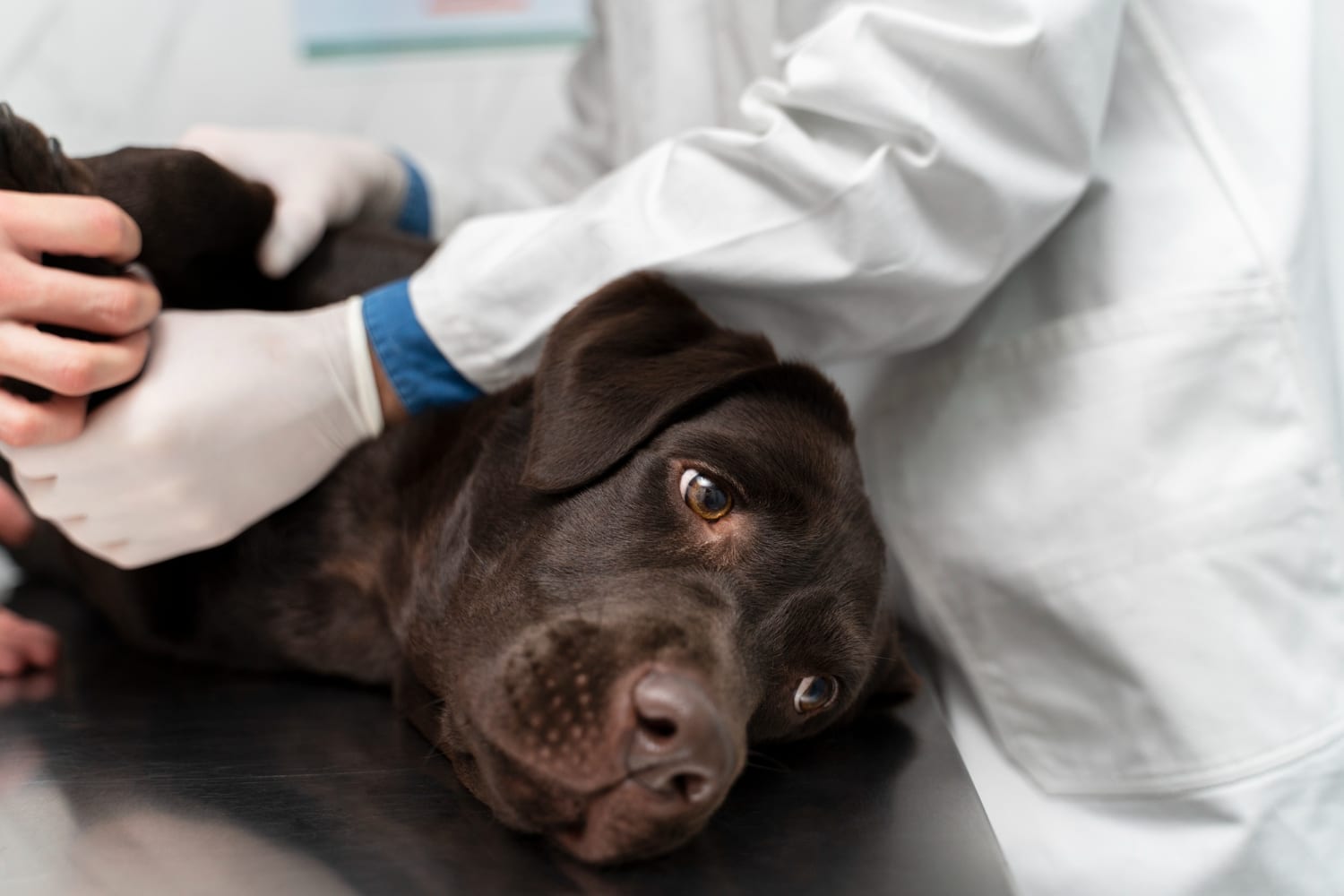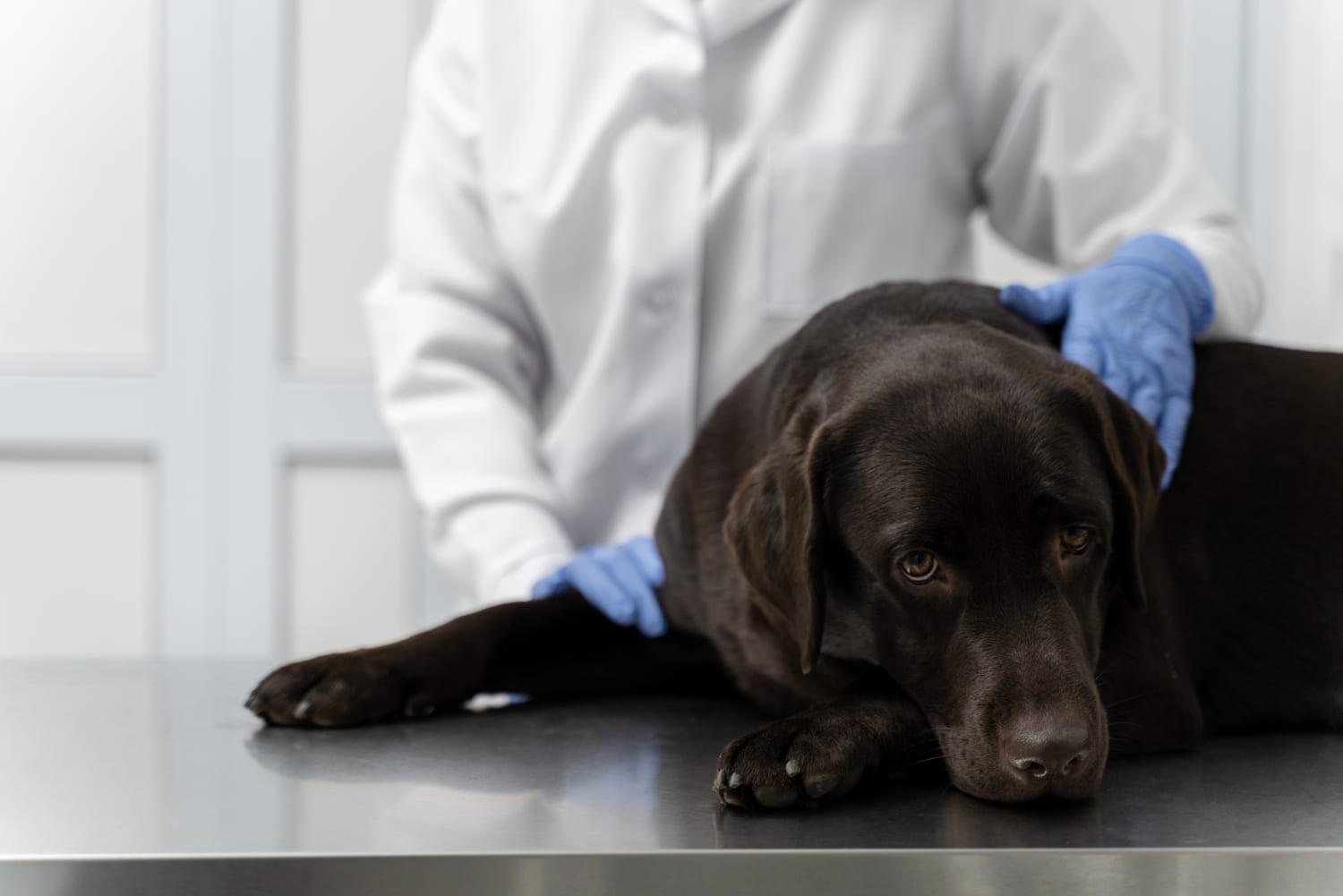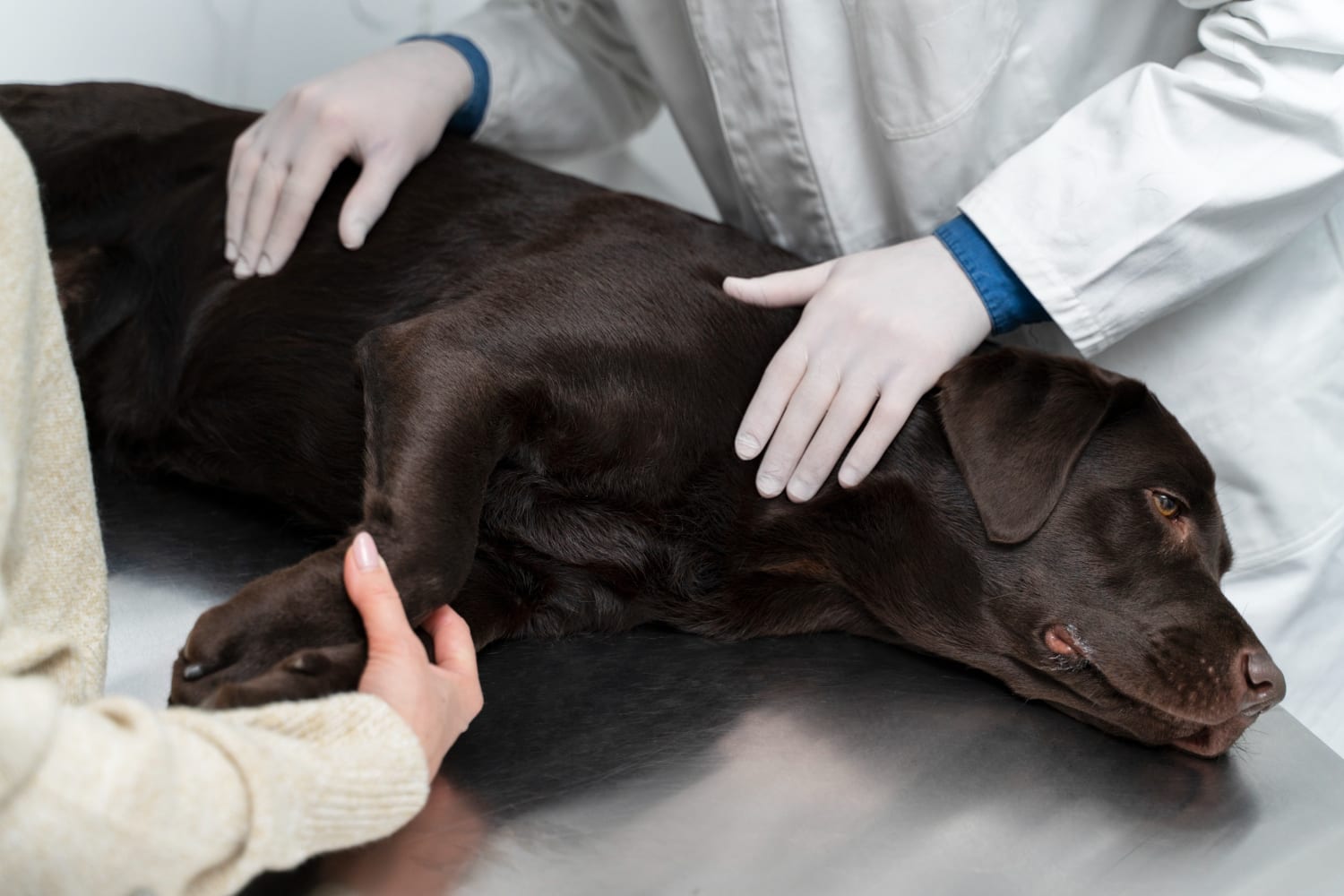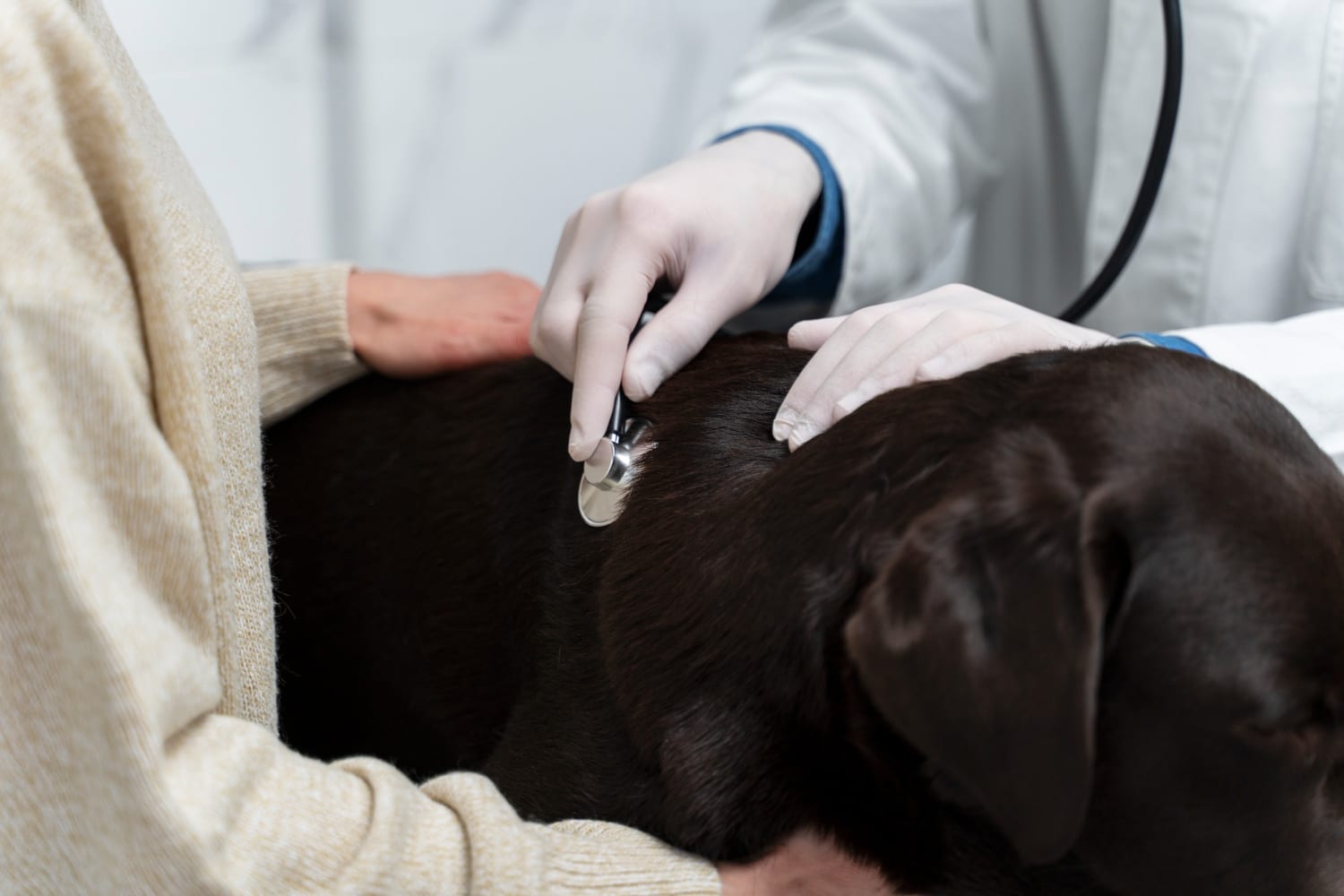Pancreatitis in Dogs: Signs, Causes and Treatment

By Evelyn Harcourt
juni 03, 2025 - 1 min read
Pancreatitis in dogs can be very serious, although how severely an animal is affected varies. Some individuals are more prone to developing this condition, but it can happen in any dog.
This article provides guidance on the potential signs to watch out for, the range of possible triggers and the treatment options available. You’ll also learn how to tell when the patient needs to be seen urgently, and what you can do to prevent future episodes of pancreatitis in your furry friend.
What is Pancreatitis in Dogs?
Pancreatitis is an inflammation of the pancreas, which becomes swollen and can no longer work effectively. The pancreas is situated at the cranial end of the abdomen (towards the front, near the stomach).
Some dogs are only mildly affected and can be treated as outpatients, while others become very unwell and need to be in the hospital for a week or more.
Role of the Pancreas
The pancreas is an organ that secretes insulin and glucagon to control blood sugar levels, as well as digestive enzymes. It also secretes bicarbonate, which helps to neutralise the stomach acid released into the small intestine.
Acute vs. Chronic Pancreatitis
Acute pancreatitis means that the inflammation occurs rapidly and is relatively short-lived. In contrast, a chronic flare-up is more of a long-term condition, with ongoing signs that can wax and wane.
Those with chronic pancreatitis have permanent changes within their pancreas that cannot be reversed. Acute pancreatitis may lead to chronic pancreatitis, but they are two separate conditions.

Signs and Symptoms of Canine Pancreatitis
Frustratingly, the signs of pancreatitis are not unique to this disease; many other conditions have similar signs. This means that it is often mistaken for something else, such as a severe bout of gastroenteritis, heart failure, or even back pain.
Early Symptoms to Watch for
Some of the earliest symptoms include a reduced appetite, vomiting, diarrhoea, panting, a fever, a hunched position, lethargy and mild dehydration.
As the dog has a very painful abdomen, you may notice that it is tensing its belly, which can even seem bloated. It may also go into the ‘downward dog’ position and stretch more in an effort to ease the discomfort.
Severe or Emergency Symptoms
As the condition progresses, some dogs will develop more serious symptoms. These can include:
- Jaundice (yellowing of the skin and mucous membranes)
- Severe dehydration
- Weakness or collapse
- Inability to hold down any food
How It Differs From Other Conditions
As mentioned, it can be challenging to distinguish pancreatitis from other diseases, particularly if the patient only has some of the clinical symptoms. However, a telltale sign of pancreatitis is the severe pain dogs experience in their cranial abdomen.
Your dog probably won’t tolerate being touched in this area and may guard it. You’ll also notice that it is walking stiffly and hunching its body over in an attempt to alleviate the discomfort.

What Causes Pancreatitis in Dogs?
We do not always know the specific cause of pancreatitis, though certain criteria can make a dog more prone to developing it.
Dietary Triggers
It has been known for some time that high-fat and greasy foods, such as hamburgers, butter, pork belly, olive oil, and bacon, can inflame the pancreas.
The pancreas goes into ‘overload’ trying to break down the excessive fat it is presented with, and the abundance of pancreatic enzymes released causes localised damage and inflammation.
Underlying Health Conditions
Certain hormonal imbalances, such as Cushing’s disease, hypothyroidism, and diabetes, can all make a dog more prone to pancreatitis. Those with elevated blood calcium (hypercalcaemia) and lipids (hyperlipidaemia) are also proven to be at increased risk.
There is also a theory that certain immune-mediated diseases could be at play for some dogs, as is the case in humans.
Medications and Toxins
Certain epilepsy (Potassium Bromide), chemotherapy, and antibiotic medications are also known to predispose dogs to an inflamed pancreas. Less commonly, it has been documented that insecticide exposure is a potential trigger.
Genetics
Genetics also play a role. We know this because certain breeds, such as the Miniature Schnauzer and the Poodle, are at a higher risk of pancreatitis than their peers.
Variants in the SPINK1 gene are thought to increase the risk in the Mini Schnauzer. Indeed, they have a 4.51 times higher chance of developing this condition compared to other breeds.

How is Pancreatitis Diagnosed?
Your vet will be suspicious of pancreatitis once you’ve described the symptoms your dog is having, but they cannot make a diagnosis without first running some tests. They will consider your dog’s age and breed, medical history, and any medicine they are currently taking.
Clinical Examination
During a clinical exam, your vet will check for some of the tell-tale signs of the disease, such as dehydration, an elevated heart and breathing rate (due to the pain), tenderness in the cranial abdomen, and a fever.
Blood Tests and Imaging
If your vet suspects pancreatitis, they are likely to run blood tests (haematology, biochemistry, and pancreatitis SNAP or cPL test) and urine tests. They may also perform an ultrasound scan of the abdomen, focusing on the liver, pancreas, and biliary system.
Treatment for Pancreatitis in Dogs
Once a diagnosis has been reached, your veterinarian will start a treatment plan. This varies from one patient to another as it depends on how severe their pancreatitis is and their symptoms.
Hospitalisation and IV Fluids
Many patients will need to stay in the hospital for a few days, particularly if they are off their food or unable to hold down water. This is especially important so that medicine can be given in an injectable form, as the oral route is not an option.
Intravenous crystalloid fluids are given to counteract the dehydration and replace the lost salts and sugars. Fresh frozen plasma may also be considered for the most severely affected patients.
Pain Management and Anti-Nausea Drugs
As these dogs are in a great deal of pain, they need to be given strong pain relief promptly and regularly. Opioids are commonly given as a continuous rate infusion.
Dogs are typically provided with anti-nausea medicine to reduce constant nausea and episodes of vomiting. This enables them to eat or accept tube feeding. In the past, food was withheld after a diagnosis of pancreatitis, but it is now thought that it is better to continue to feed the patient.
Long-Term Dietary Changes
Once a dog recovers from pancreatitis, it is generally advised that it be kept on a low-fat diet. This means avoiding high-fat treats, chews and changing to dog food that contains less fat than average.
The amount advised varies, but most vets recommend a diet containing about 8-12% fat.

Recovery and Home Care for Pancreatitis in Dogs
Dogs can be unwell for several weeks after a bout of severe pancreatitis, and after discharge from the hospital, will still need to be closely monitored and cared for at home.
Feeding Guidelines After Diagnosis
You’ll want to offer a low-fat, highly digestible, and palatable diet. Small and frequent meals can be useful to prevent vomiting and prevent the pancreas from being overloaded.
It is best not to offer your dog any human foods, as many are higher in fat than would be recommended. Some foods that should be avoided at all costs include greasy meats, dairy such as cheese, processed foods (like crisps), and oils. This includes skin supplements, like salmon oil.
Monitoring for Recurrence
Owners should be aware of the early signs of pancreatitis to bring their dog back to the veterinary clinic at the first sign of recurrence. This can include vomiting, frequent stretching, and going into the downward dog position.
Preventing Pancreatitis in Dogs
Although every owner wants to avoid pancreatitis, this prevention advice is especially pertinent for those who own dogs that have experienced at least one episode of pancreatitis in their past.
Avoiding Fatty Foods and Table Scraps
Rather than trying to limit amounts or set thresholds, greasy and fatty foods should simply be avoided at all costs. This means no table scraps or sharing meals. If your dog is a scavenger, you’ll need to be extra cautious when keeping your food well out of their reach.
Regular Health Screenings
Don’t hesitate to go to your local vet for a check-up if you’re concerned your dog is starting to show signs of pancreatitis. They can check them over and may perform some initial tests (blood tests and abdominal imaging) to assess the health of the pancreas and determine if your dog may need support.
Your vet is also there to assist you if your dog is on long-term medication or needs help with a weight loss and diet plan.
Managing Weight and Chronic Illnesses
Obesity is a significant risk factor for developing pancreatitis, not just because it is associated with higher-fat diets.
Excess fat stores can disrupt normal metabolism and lead to excess triglycerides in the blood. We want to be preventative in our pet care and aim for a Body Condition Score of 3-4 out of 9.
Regular vet visits are also key if your dog is managing a chronic illness, such as diabetes or hypothyroidism. Routine blood tests can monitor organ health and ensure your dog is coping well.

When to Call the Vet
Contact your vet at the first sign of pancreatitis, as the sooner your pet can receive treatment, the better. It is reasonable to call an emergency vet if your dog is persistently vomiting, is dehydrated, or seems in pain.
Learn More About Pancreatitis in Dogs
You are always welcome to contact us if you have any questions about your dog and pancreatitis.
We have a wealth of knowledge about the disease's acute and chronic forms and are here to guide you.
Pancreatitis in Dogs FAQs
Can Dogs Recover Fully From Pancreatitis?
It is certainly possible for dogs to completely recover from an acute pancreatitis episode, mainly if there was a known trigger such as a medicine or toxin exposure. The situation is more complex when it comes to chronic pancreatitis, which causes irreparable damage.
What Should I Feed My Dog?
Once recovered from pancreatitis, it is best to stick to a bland diet that is low in fat and highly digestible. There are commercial diets available which have been tailored for this purpose, and your dog can be fed either wet or dry food.
Is Pancreatitis in Dogs Life-Threatening?
Sadly, pancreatitis does have the potential to be life-threatening. Early diagnosis and treatment improve the prognosis, but very severe cases could lead to the patient's passing away.
Continue reading

Signs a Cat is in Pain and How to Recognise Them
Learn how to recognise pain in your cat and the subtle signs to look out for.
Read article
What to Do If Your Dog Eats Chocolate?
Learn what to do if your dog eats chocolate and the signs of toxicity to look out for.
Read article
Signs of Hypothermia in a Dog and How to Treat It
Learn the signs of dog hypothermia and how to treat it quickly and safely.
Read article